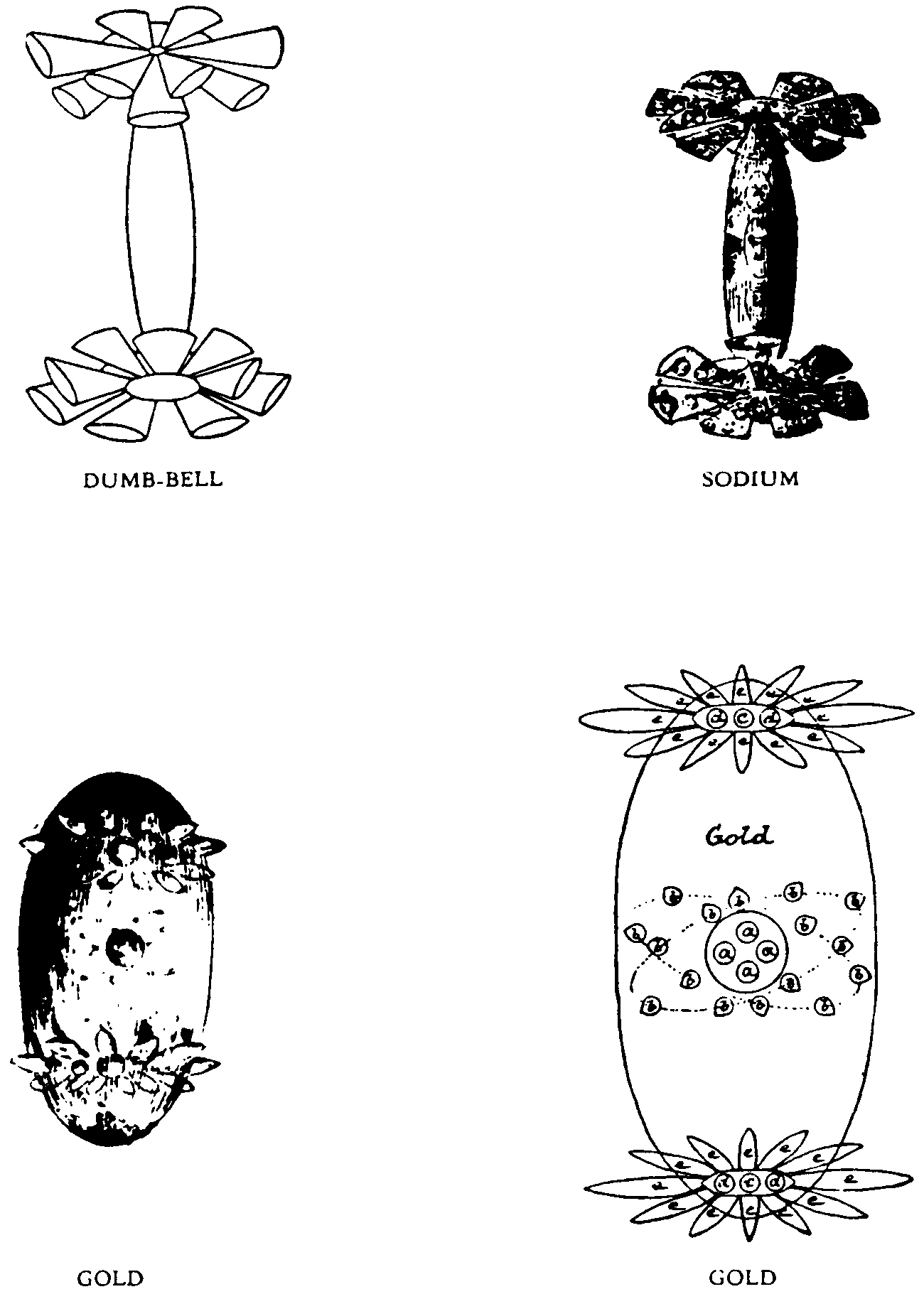
FIG.
30. TYPES OF THE DUMB-BELL GROUP
CHAPTER IV
THE DUMB-BELL GROUP

FIG.
30. TYPES OF THE DUMB-BELL GROUP
CHAPTER IV
THE DUMB-BELL GROUP
THE ten elements in this group are all of one type. What the type is will be seen from Fig. 30 : the general shape was called a dumb-bell, as the best word to describe these elements. Each dumb-bell is composed of
3. An exactly similar lower part, composed of twelve funnels, radiating from a similar globe.
In the diagrams we give the connecting rod, the globe and one funnel. It will be seen that here, as in the spike group, we find certain characteristic groups which are built. into many of the elements.
The connecting rod in five elements is the same, and to this group we have given the distinguishing name of CL19. The rod in the last four elements steadily increases in size. The constituents of the Occultum atom appear frequently in Samarium. Erbium, Gold and 85. In the connecting rod. whenever there are two columns, as in Sarnariurr they revolve perpendicularly round a common centre. When there are three columns. as in Erbium, they revolve round a centre which is the connecting rod CL19, the three columns being at the corners of a triangle. When there are four columns, as in 85, they revolve round a common centre, being at the corners of a square. The connecting rod of gold is exceptional as it does not contain columns.
The globes increase steadily in size as the weight increases. The analysis shows how these are built up.
The funnels also increase in size. One very important group, C1.25, occurs in all the elements of this group from chlorine onwards.
Sodium is the simplest of the Dumb-bell group. It consists of a central rod, the bar of the dumb-bell, at each end of which is a globe from which radiate twelve funnels. Rod. The rod consists of fourteen Anu arranged in three spheres of four, six and four Anu
respectively. Globe. The globe from which the funnels radiate consists of two concentric spheres. In the inner one are four Anu, while six Anu are found in the outer circle. Funnel. Each funnel shows four enclosed bodies, chiefly made up of duads, as shown in Fig. 31.
Sodium
= Na14 + 2 Na10 + 24 Na16.
Connecting
rod = 14 Amu
Upper
part, 12 funnels of 16 Anu = 192
Lower
part, 12 funnels of 16 Anu = 192
Total
= 418 Anu
THE
DUMB-BELL GROUP 65
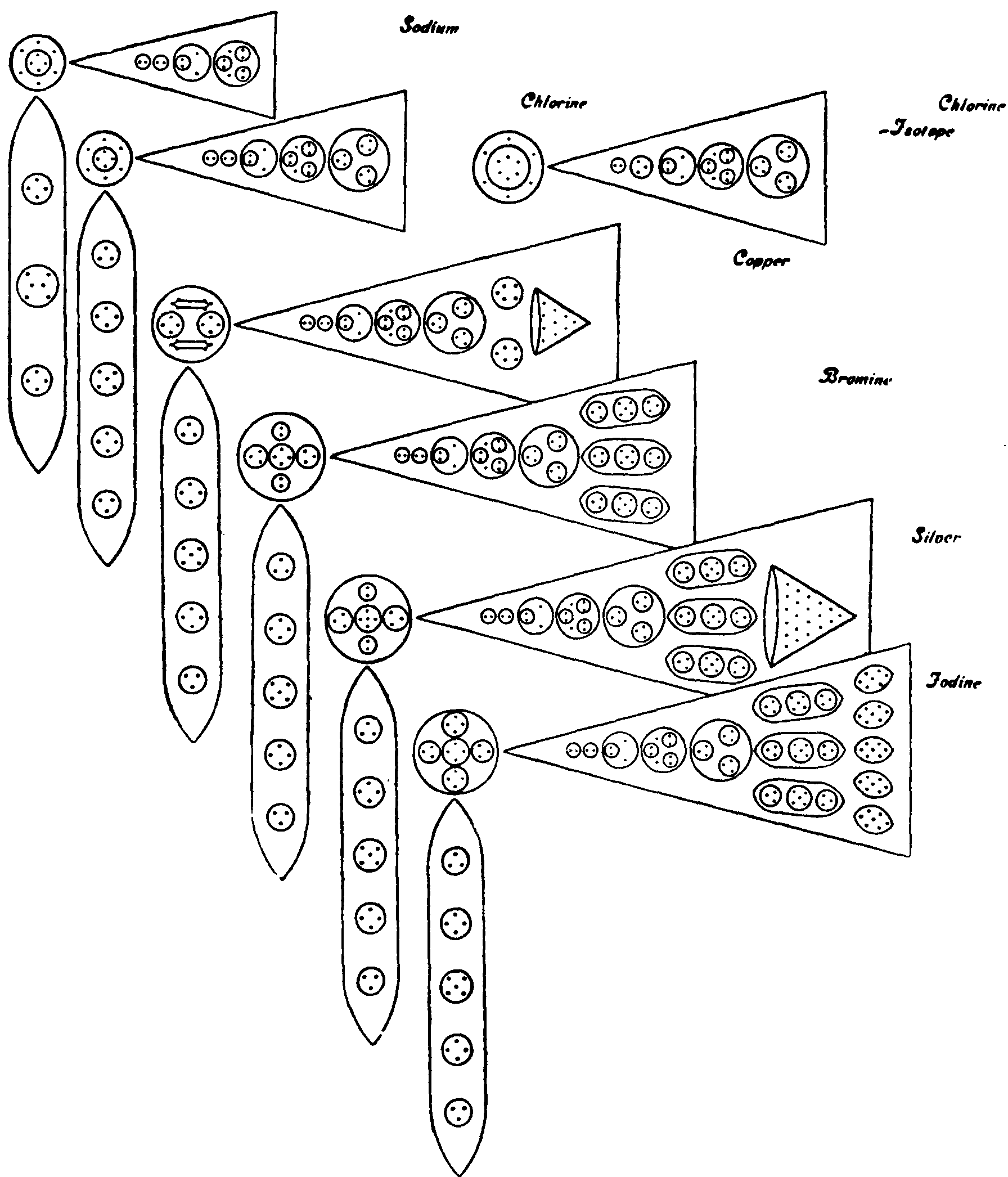
FIG.
31. SODIUM, CHLORINE. COPPER, BROMINE. SILVER. IODINE
66 OCCULT CHEMISTRY,
ATOMIC
No. 17. CHLORINE
Chlorine
contains
some of the fundamental patterns used in this group. Fig. 31.
Rod.
In
the rod we find an arrangement of five small spheres, containing three,
four, five, four and three Anu respectively. This makes up the characteristic
group C1.19 which occurs again in a number of elements in the group.
Globe.
The globes are the same as those in Sodium.
Funnel.
The funnel, shown flat as an isosceles triangle, is a somewhat complicated
structure, of the same type as that in Sodium, the difference consisting
in the addition of one more sphere containing nine Anu. The whole funnel
forms the characteristic group C125, which occurs in all the succeeding
elements in the group.
These
dose similarities point to some real relation between these elements. Chlorine
= CL19 + 2Na10 + 24025.
Connecting
rod = 19 Anu
Upper
part, 12 funnels of 25 Anu = 300 _
Lower
part, 12 funnels of 25 Anu = 300
ISOTOPE OF CHLORINE
This
was specially looked for in sea water and found. The difference consists
in the addition of one Anu to each of the 24 funnels, and of two Anu to
each of the two globes round which the funnels revolve. A funnel of Chlorine
consists of five spheres containing respectively 2, 2, 4, 8, and
9 Anu. In the isotope, the arrangement is 2, 3, 4, 8, and 9. Each central
globe of Chlorine
contains ten
Anu, an inner sphere of four Anu
surrounded by an outer of six. In the isotope the central globe contains
twelve Anu, an inner sphere of six Anu at the points of an octohedron,
and an outer sphere of six. Fig. 31.
The isotope is less common than the normal variety of Chlorine. Though a thorough investigation was not made of the difference between Chlorine and its isotope, nevertheless the impression gained was that the isotope was more positive than Chlorine.
Chlorine
a = CL19 -f- 2 (Na10 + 2) -f- 24 C126
Connecting
rod = 19 Anu
Upper
part, 12 funnels of 26 Anu = 312 _
Central
globe = 12
Lower
part, 12 funnels of 26 Anu = 312
Central
globe = ' 12
Total
= 667 Anu
THE
DUMB-BELL GROUP 6'T
ATOMIC
NO. 29. COPPER
Rod.
The
connecting rod in Copper is exactly the same as that in Chlorine, Cl.19.
Globe.
The
central globe contains two spheres of four Anu and a prism-shaped group
containing six Anu. This is the Ad6 group, which is one of the most common
of the constituent groups.
Funnel. The main portion of the funnel is that -ef-Chlorine, C125. The funnel also contains additional bodies, notably a triangular cone containing ten Anu. Such a cone, built of varying numbers of Anu, occurs in other elements, such as Gold. Iron and Platinum. There are also two quintets, 2B5. Fig. 31.
Copper
= C1.19 + 2 (2Be4 -f- 2Ad6) + 24 (C125 + 2B5 + Cu10)
Connecting
rod = 19 Anu
Upper
part. 12 funnels of 45 Anu = 540
Central
globe - 20 ,.
Lower
part, 12 funnels of 45 Anu - 540
Central
globe = 20
Total
= 1139 Anu
Rod.
In
Bromine the connecting rod remains unchanged, Cl.19.
Globe.
The
globe seems to be formed from that of Chlorine. Two pairs of Anu are added
and a rearrangement is effected by drawing together and lessening the swing
of the pairs of triplets, thus making room for the newcomers.
Funnel.
Each
funnel consists of the C1.25 and three additional groups, Gell, ovoid in
shape, and each containing eleven Anu. Thus thirty-three Anu are added
without any disturbance of form. The total number of Anu is here raised
to 1,439. Fig. 31.
Over and over again, in these investigations, were we reminded of Tyndall's fascinating description of crystal building, and his fancy of the tiny. ingenious builders busied therein. Truly are there such builders, and the ingenuity and effectiveness of their devices are delightful to see. Theosophists call them Nature-spirits, and often use the mediaeval term elementals. Beings concerned with the elements truly are they. even with chemical elements.
Bromine
= C1.19 + 2 (Be4 + 2H3 + 2N2) + 24(C125. -f- 3Ge11)
Connecting
rod = 19 Anu
Upper
part, 12 funnels of 58 Anu = 696
Central
globe = 14
Lower
part, 12 funnels of 58 Anu = 696 _
Central
globe = 14
Total
= 1439 Anu
Number
weight 1 $9 = 79.914
68
OCCULT CHEMISTRY
ATOMIC NO 47. SILVER
Rod. The connecting rod in Silver is the C1.19.
Globe. The globe is similar to that in Bromine, except that the small central sphere has five Anu instead of four.
Funnel. The funnel contains the C125 and the three Gell, as in Bromine, but it adds a triangular group of 21 Anu. In this it resembles copper and other metals. Fig. 31.
Silver - C1.19 -f- 2 (m-Ne5 -+- 2H3 -t- 2N2) -f-- 24 (Cl.25 -E- 3 Gell + Ag21)
Connecting
rod = 19 Anu
Upper
part, 12 funnels of 79 Anu = - 948
Central
globe - 15 _
Lower
part, 12 funnels of 79 Anu = 948
Central
globe = 15
Total = 1945 Anu
Number weight 11 85 = 108.06
ATOMIC NO. 53. IODINE
Rod. The connecting rod is the C1.19.
Globe. The central globe contains three quartets and two triplets.
Funnel. The funnel contains the C1.25 and three Gell, as in Bromine, and adds five ovoids, 1.7, each containing seven Anu. Fig. 31. Iodine = C1.19 -1- 2 (3Be4 -(- 2H3) + 24 (C1.25 -f3Ge11 + 51.7)
Connecting rod =- 19Anu
Upper
part, 12 funnels of 93 Anu = 1116
Central
globe = 18
Lower
part, 12 funnels of 93 Anu = 1116
Central
globe = 18 _
Total = 2287 Anu
Number
weight ~ - 127.06
THE
DUMB BELL GROUP 69
ATOMIC
No. 6Z
SAMARIUM
This
element seems to be an intermediate stage between Silver and Gold. Fig.
32. Rod. The connecting rod is yet in embryo, for it has not the wonderful
solar system which makes so splendid an appearance in Gold. It has evolved
already the curious form, Sm84, with its four ropelike rings, Oc. 15..
borrowed from Occultum. Two of these Sm84 groups appear in Samarium and
four in Gold. The Au33 groups, also derived from Occultum. which rotate
round the central sphere in the rod of Gold. appear in this element but
are curiously doubled.
The
rod contains, in all. six bodies, forming two columns which revolve round
a common centre. The rod will be found on close examination to be constructed
from the constituents of eight atoms of Occultum.
Globe.
The globes at the top and bottom of the dumb-bell have now become a complex
body which may be distinguished as Sm101. Each globe consists of a central
small sphere of five Anu, surrounded by a ring of six duads. These are
again surrounded by a ring of twelve L7 groups.
Funnel.
The
funnels are identical with those of Silver, except that the C125 is slightly
rearranged and there are four Gell instead of three. It contains the triangularshaped
body containing 21Anu, Ag21.
There
is some reason to believe that this element is the Aurichalcum
of
the Atlanteans, as described by Plato. If so, it probably exists in much
greater quantity than is yet known.
Samarium is considered to be one of the Rare Earths and chemists are undecided how best to assign places in the Periodic Table to these elements. It will be seen that the arrangement suggested in this book. and confirmed by the sequence of characteristic shapes, gives a scheme whereby all these elements fall naturally into the groups.
Samarium
=_ (2Sm84 + 4Sm66) + 2Sm101 + 24 (C125 + 4Ge11 -1- Ag21)
Connecting
rod == 432 Anu
Upper
part. 12 funnels of 90 Anu = 1080
Lower
part. 12 funnels of 90 Anu == 1080
70
OCCULT CHEMISTRY
ATOMIC NO. 6a. ERBIUM
Rod. The connecting rod follows the pattern of Samarium, but it contains three columns instead of two and these columns contain the constituents of twelve Occultum atoms. In addition there is the group C1.19 which appears as the connecting rod in the earlier elements. The three columns are placed at the corners of a triangle and revolve round the C1.19. Globe. The globe is the Sm101 group which forms the globe of Samarium. Funnel. The funnels are identical with those of Samarium. Fig. 32.
Erbium
- (Cl.19 + 3Sm84 + 6Sm66) + 2Sm101 + 24 (025 + 4 Ge11 -r Ag21)
Connecting
rod = 667 Anu
Upper
part, 12 funnels of 90 Anu = 1080
Central
globe - 101 _
Lower
part, 12 funnels of 90 Anu = 1080 _
Central
globe = 101
Total
= 3029 Anu
THE
DUMB-BELL GROUP 71
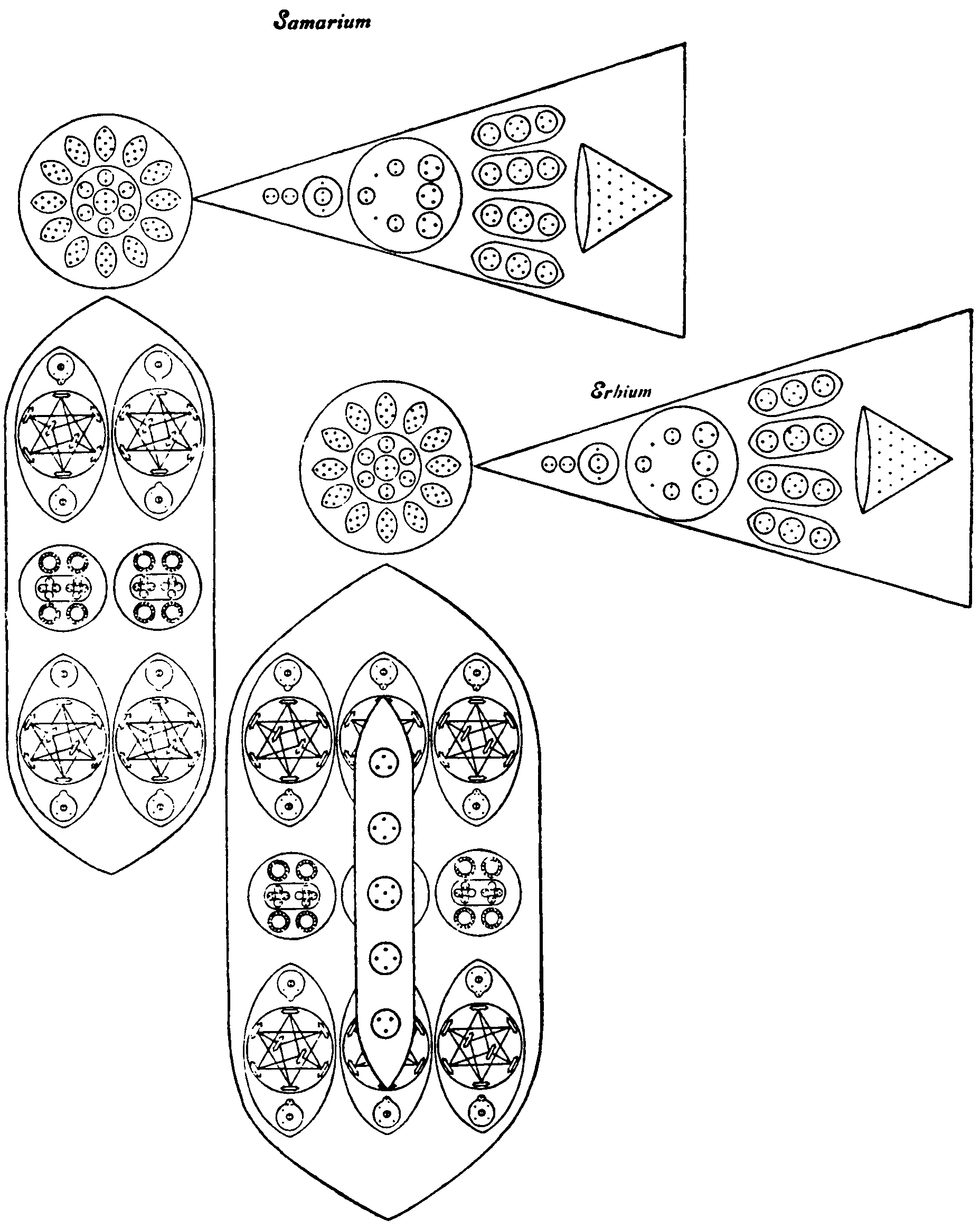
FIG.
32. SAMARIUM, ERBIUM
-72 OCCULT CHEMISTRY
ATOMIC
NO. 79 GOLD
Gold
is so complicated thaf it is difficult to recognise the familiar dumb-bell
in this elongated egg, but when we come to examine it the characteristic
groupings appear. The egg is the enormously swollen connecting rod, and
the upper and lower funnels with their central globes are the almond-like
projections radiating from an ovoid. Round each almond is a shadowy funnel
(not drawn in the diagram) and within the almond is the collection of bodies
shown in the diagram of the funnel. Figs. 30 and 33.
Rod.
The
rod contains four groups, Sm84, in the centre, and sixteen Au33 group circling
round them. These sixteen groups are arranged in two planes inclined to
one another. The whole rod is made from the constituents of sixteen atoms
of Occultum.
Globe.
The central globe here becomes an ovoid and is made up of one sphere, as
in Samarium, Sm101, and two new spheres, Au38.
Funnel. The funnels are exactly like those of Samarium and Erbium except that the triangular body has twenty-eight Anu, as in Iron.
Gold
= (4Sm84 + 16Au33) -I- 2 (Sm101 + 2Au38) -I- 24 (C125 -I- 4Ge11 -b Fe28).
Connecting
rod = 864 Anu
Upper
part, 12 funnels of 97 Anu = 1164
Lower
part, 12 funnels of 97 Anu - 1164 _
THE
DUMB-BELL GROUP 73
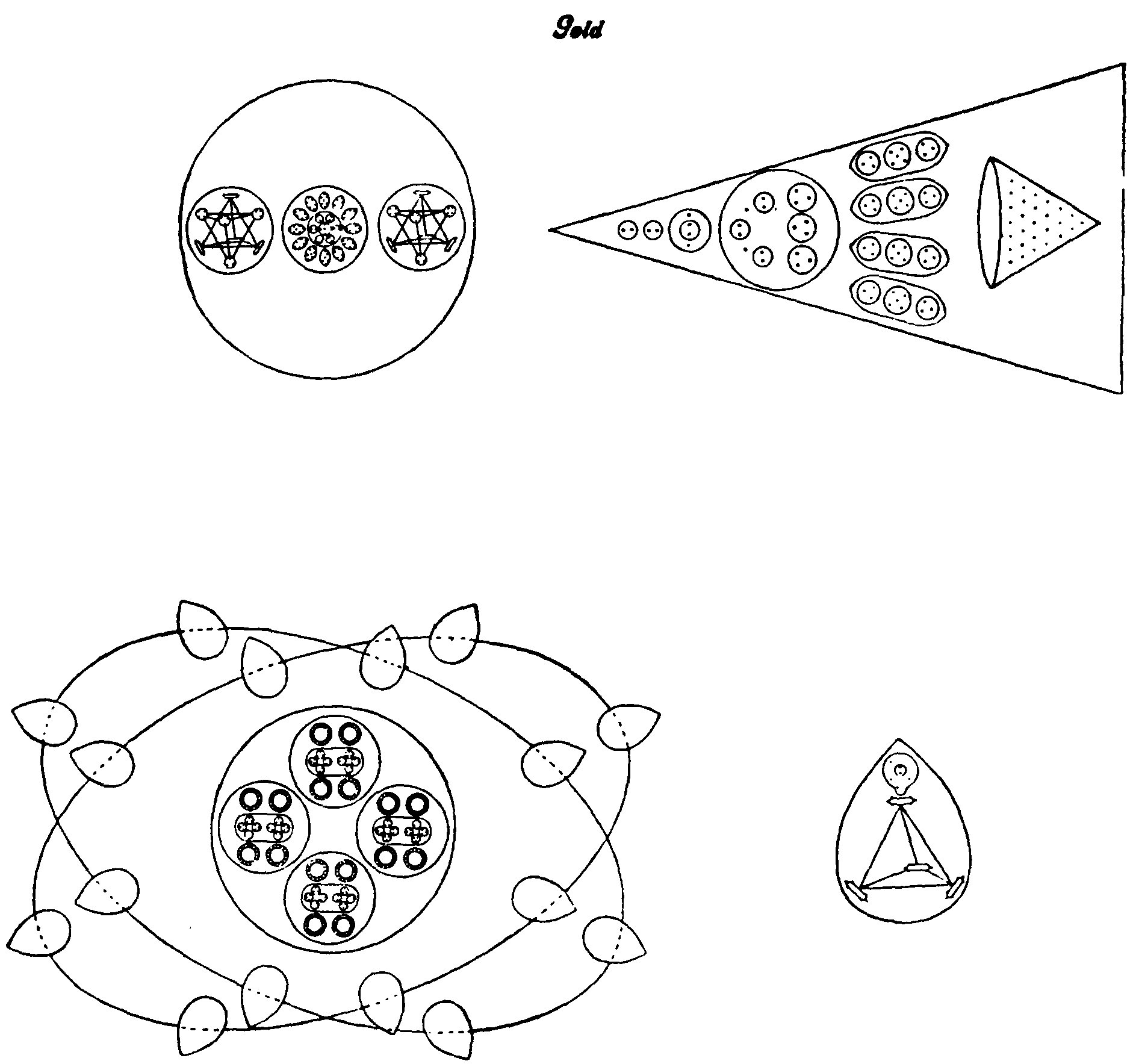
FIG.
33. GOLD
74 OCCULT CHEMISTRY
ATOMIC NO. 85.
85
This
element follows the pattern of Samarium and Erbium. Figs. 32 and 34.
Rod.
The
rod is very large and, like that of gold, contains the constituents of
sixteen Occultum atoms. In No. 85, however, these groups are arranged in
columns as in Samarium, though here we have four columns instead of two.
The four columns are arranged at the corners of a square and rotate round
a centre.
Globe.
The globe is as in gold and contains one Sm101 and two Au38 spheres.
Funnel. The funnel is like that of Gold but there are 18 extra Anu packed in. This is done, first by adding two Anu to the C125 unit, two of the upper duads becoming triplets. Then instead of the four Gell groups we have four groups made up of two spheres of four Amu and one sphere of seven Anu. So we have four groups of fifteen Anu instead of four of eleven. The Fe28 cone comes at the mouth of the funnel.
85
= Au864 + 2 (Sm101 +- 2 Au38) -f- 24 (Cl. 25-2 + 4. 85. 15 -+- Fe28)
Connecting
rod = 864 Anu
Upper
part, 12 funnels of 115 Anu = 1380
Central
globe = 177 _
Lower
part, 12 funnels of 115 Anu = 1380
Central
globe = 177 _
Total
= 3978 Anu
THE
DUMB-BELL GROUP 73
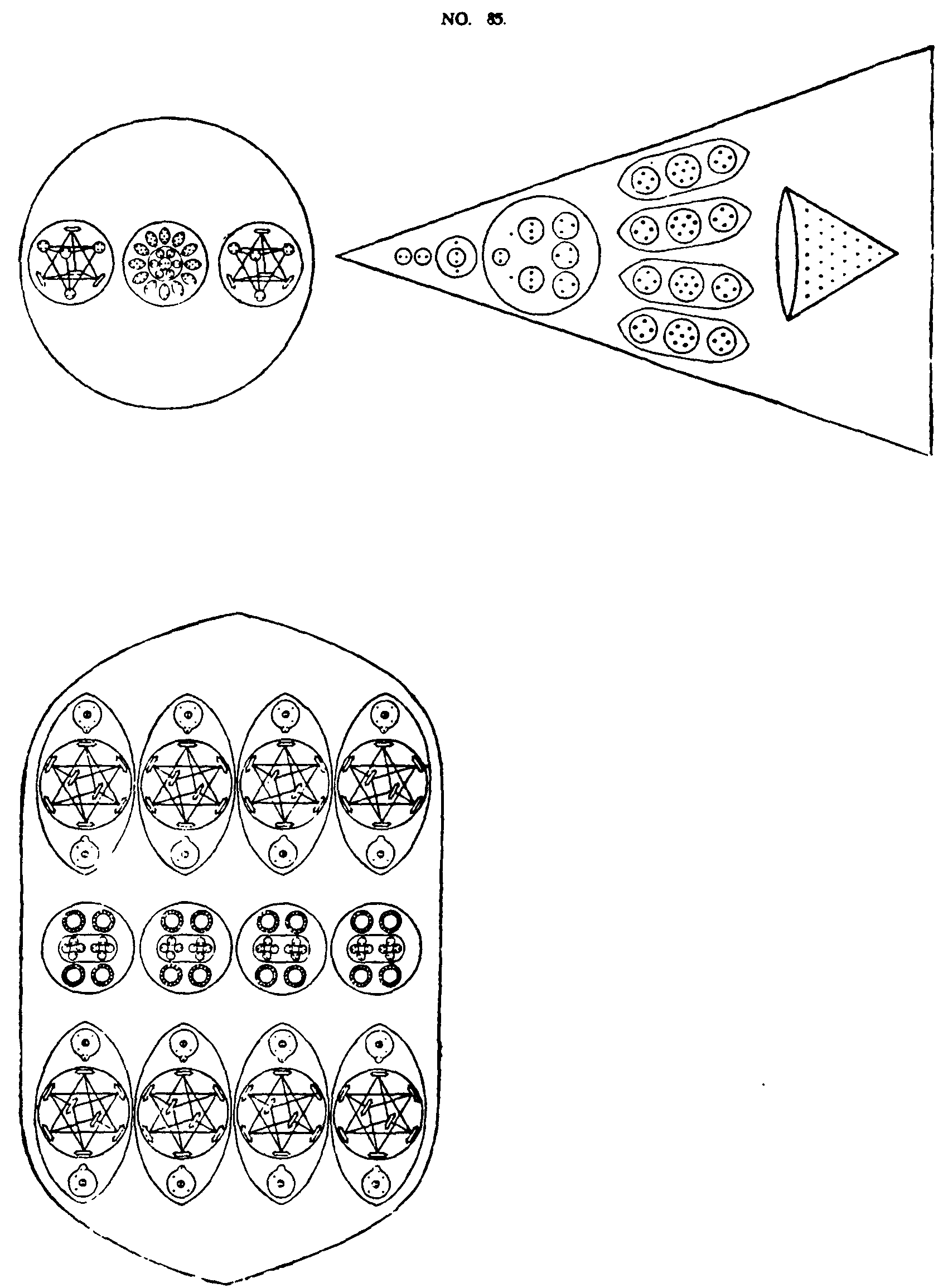
FIG.
34. NO. 85
OCCULT CHEMISTRY
76
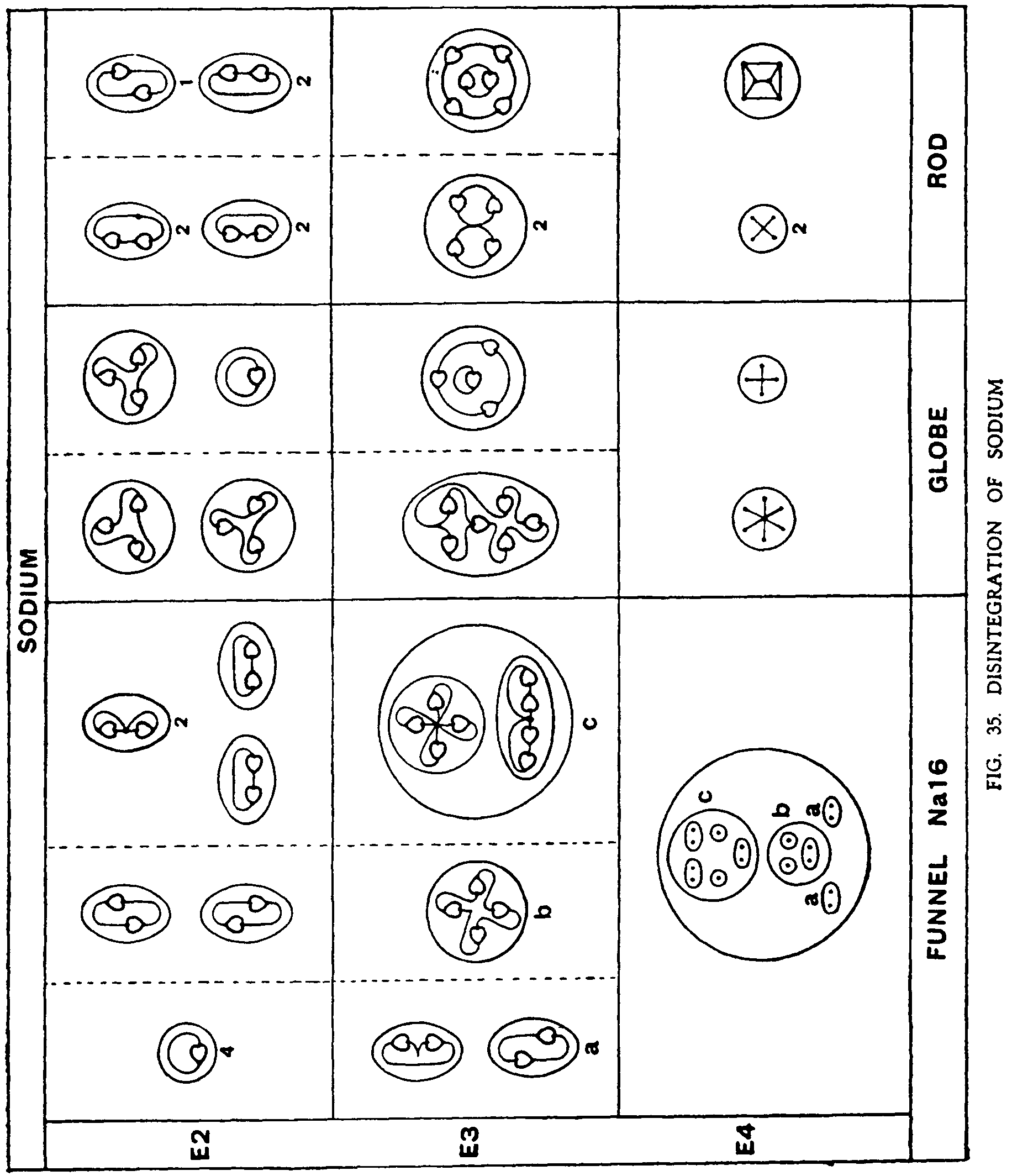
Sodium gives the basic pattern of disintegration for the whole group. Fig. 35. When Sodium is set free from its gaseous condition it divides up into 31 bodies; twentyfour separate funnels, four bodies derived from the two globes and three from the connecting rod, each with more or less complex contents.
Funnels. On the E4 level each funnel becomes a sphere containing four bodies, 2a, lb and lc.
On the E3 level the two duads a become entirely independent and on the E2 level the four Anu break off from each other and gyrate in independent solitude.
The contents of the b group unite into a quartet which, on the E2 level, yields two duads.
The contents of the group c are re-arranged on the E3 level, giving two groups of four within a common sphere. On the E2 level the sphere yields four duads.
Globes. Each globe yields a sextet and a quartet on the E4 level. On the E3 level the sextet, with its six Anu whirling round a common centre, becomes grouped into two triplets, preparing for the complete separation of these on the E2 level.
The quartet, a whirling cross with an Anu at each point, becomes a quartet on the E3 level, in which three Anu revolve round a fourth. In the E2 state the central Anu is set free, resulting in a triplet and a unit.
Rod. On the E4 level the rod sets free two quartets and a peculiarly formed sextet. Each of the quartets liberated from the Rod shows four Anu whirling round a common centre, exactly resembling in appearance the quartet from the globe. But there must be some difference of inner relation for, in the E3 state, they act differently. Those from the Rod re-arrange themselves as two pairs and divide into two duads on the E2 level.
The sextet is a four-sided pyramid with two closely joined Anu at its apex. These still cling to each other in mutual revolution as an E3 body, encircled by a ring of four. On further disintegration to the E2 level this leads to three duads.
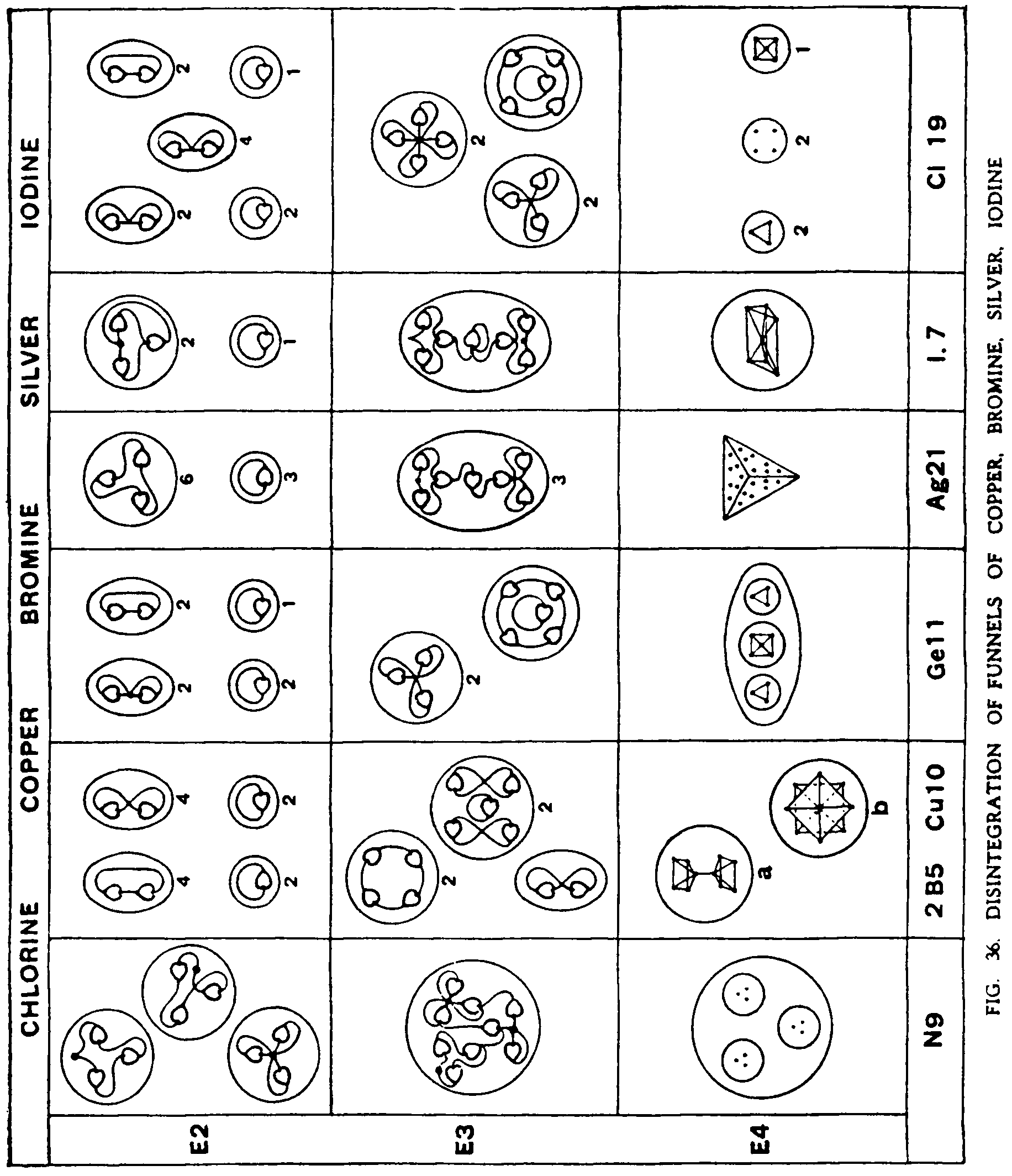
Funnels. On the E4 level the 24 funnels. C1.25. form spheres as do those of Sodium. The small additional sphere, N9, containing three groups of three Anu, remains within this funnel-sphere. Figs. 35 and 36.
Globes.
The globes are identical with those of Sodium and disintegrate in the same
way. Fig. 35.
Rod.
The connecting rod. C1.19, is common to a number of elements. Fig.
36. On the E4 level it sets free 5 bodies, two triplets, two tetrads and
a quintet, the latter in the form of a four-sided pyramid. On the E3 level
we find the two triplets and the two quartets. The quintet has become a
ring of 4 Anu whirling round a central unit. On the E2 level these further
disintegrate yielding 8 duads and 3 units.
Funnels. Each funnel in Copper contains a lower part which is identical with the funnel of Chlorine, C125. This lower part disintegrates as shown in Figs. 35 and 36. The upper part of the funnel provides us with new types, the two spheres of ten Anu. The Anu in these spheres are curiously arranged. One sphere, a, consists of two square-based pyramids, 2135, turned so as to meet at their apices. It breaks up into two quartet-ring: and a duad on the E3 level. On the E2 level it forms 4 duads and 2 units. The sphere, b, also contains two four-sided pyramids but their bases are in contact and set at right angles to each other, the second apex is not seen in the diagram as it is directly below the first. The pyramids separate as E3 bodies and the Anu assume the peculiar arrangement indicated. On the E2 level, they break up into four pairs and two units.
Globe. Fig. 37. Each globe contains two spheres of 4 Anu and two Ad6 groups. The globe is set free on the E4 level but does not break up. On the E3 level it forms two quartets and two sextets.
90
OCCULT CHEMISTRY
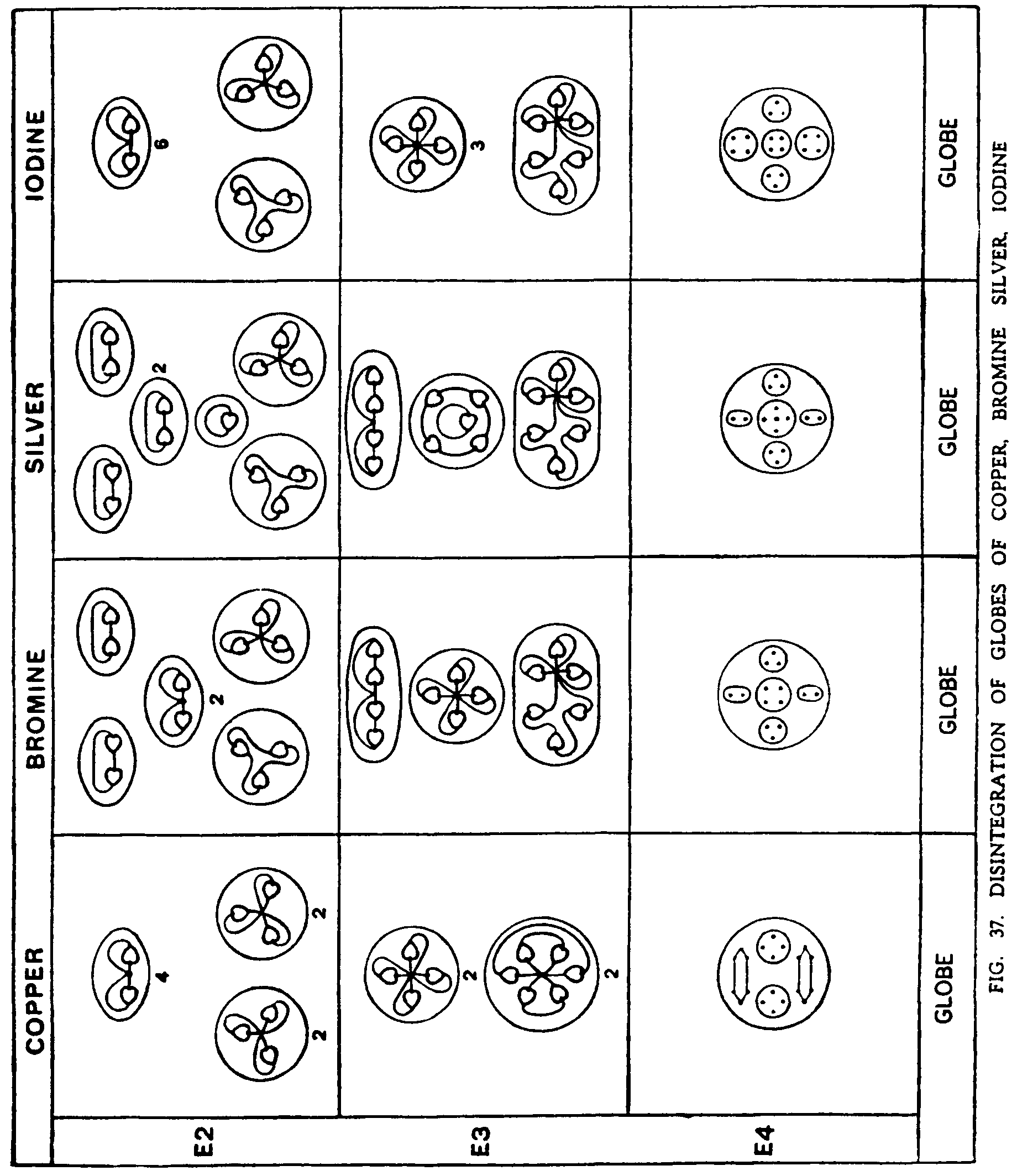
THE DUMB-BEU GROUP VP 81
DISINTEGRATION OF BROMINE
Funnels.
The
funnels of Bromine act similarly to those of Chlorine. Fig. 36. There are,
however, three extra ovoids, Ge11 each containing two triplets and a quintet.
This ovoid, which is shown in Fig. 36. give, on the E3 level. two triplets
and a ring of four Anti with another in the centre. On the E2 level we
find four duads and two units.
Globes.
The globes are set free on the E4 level. Fig. 37. The quartets and the
two triplets whirl in a plane vertical to the paper and the two duads on
a plane at right angles to this.
On
the E3 level the two duads together form a linear quartet. The central
quartet gives a whirling cross and the two triplets a single sextet.
On
the E2 level these dissociate into four duads and two triplets.
Rod.
C1.19
disintegrates as does that of Chlorine. Fig. 36.
DISINTEGRATION OF SILVER
Funnels.
The
funnels of Silver are very similar to those of Bromine. On the E4 level
we find the sphere-funnel of Chlorine. Figs. 36 and 37. Then we come to
the three ovoids, Gell, each containing two triplets and a quintet. Their
disintegrations are shown under Bromine. Fig. 36. Finally we find the triangular-shaped
body, Ag21, at the apex of the funnel. On the E4 level this forms three
triangles joined at their apices, in fact a tetrahedron in which no Anu
are distributed on the fourth face. On the E3 level these three faces separate
and give three septets. On the E2 level each of the septets gives two triplets
and a unit.
Globes.
These
are set free at the E4 level. Fig. 37. Each contains two triplets and two
duads revolving round a central group of five. The pentad and the two triplets
whirl in a plane vertical to the paper and the two duads in a plane at
right angles to this. The pentad is a four-sided pyramid on a square base.
On
disintegration to the E3 level they form a linear quartet, a sextet and
a body of five Anu. On the E2 level they disintegrate as shown in Fig.
37, giving two triplets, four duads and a unit.
Rod.
The
rod behaves as in Chlorine.
DISINTEGRATION OF IODINE
Funnels.
These
funnels are like those of Bromine, with the addition of 5 ovoid bodies,
517, at the top of each. The disintegration of the funnels is shown in
Figs. 36, 37. The lower part of the funnel acts as in Chlorine and the
3 ovoids, Gell, as in Bromine. On the E4 level the ovoids, 1.7, become
spheres when the funnels are thrown off, and a crystalline form is indicated
within the sphere. The Anu are arranged in two tetrahedrons with a common
apex, and the relationship is maintained in the E3 body, a septet. This
latter breaks up into two triplets and a unit on the E2 level. Fig. 36.
Globes.
The
globes resemble those of Bromine save that they each contain two quartets
instead of two duads on the E4 level. These disintegrate as usual on the
E3 level. giving three quartets and also one sextet as in Bromine. On the
E2 level we get two triplets and six duads.
Rod. The rod is similar to that in Chlorine and dissociates in the same way.
82
OCCULT CHEMISTRY
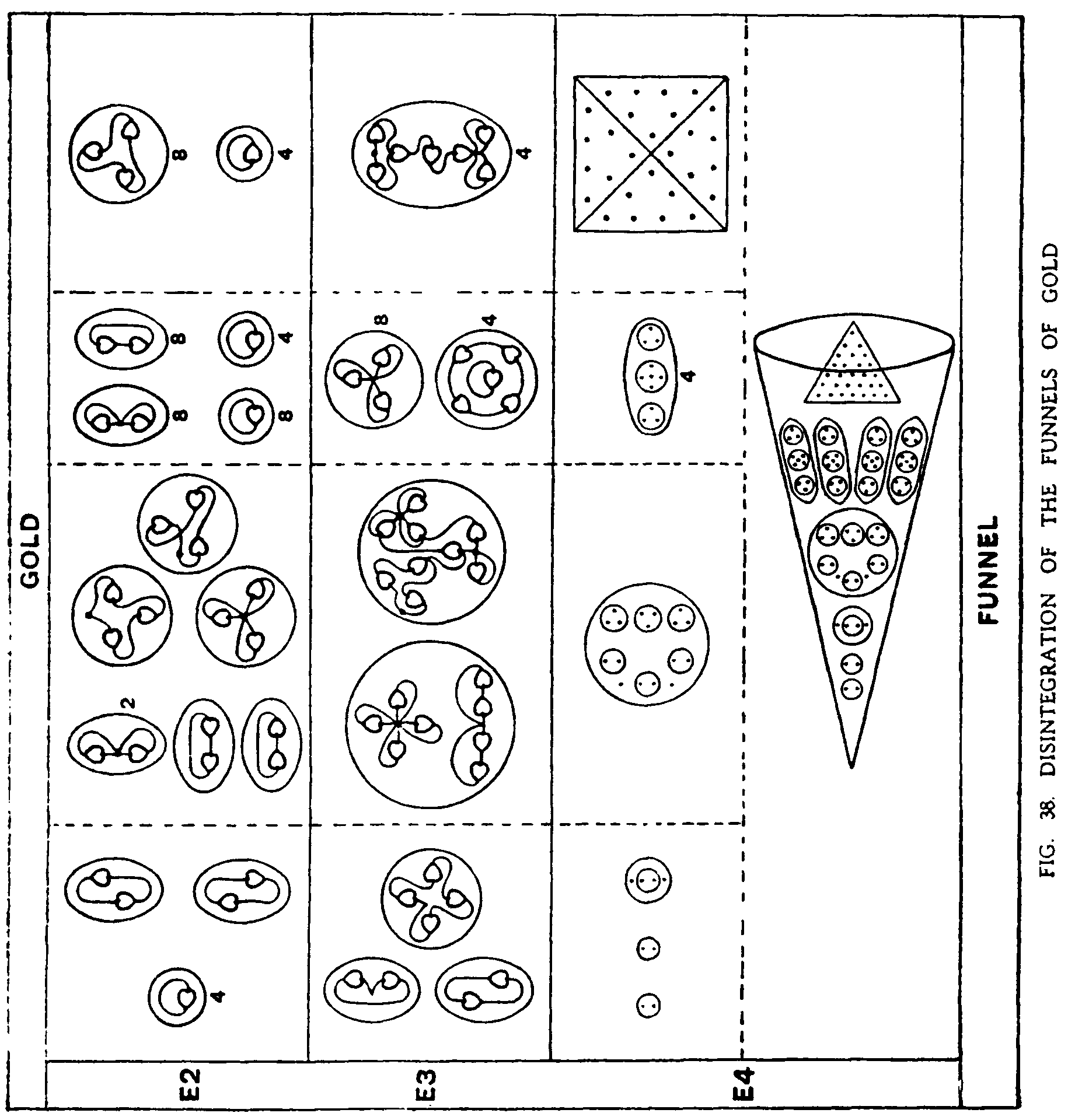
THE DUMB-BELL GROUP 83
DISINTEGRATION OF GOLD
Funnels.
Fig.
38. On the E4 level the 24 funnels first separate as complete
funnels, but this condition does not last. The motion ti of the funnels changes and they
finally
cease to exist, setting free their contents.
At
stage two on the E4 level, therefore, we have each funnel liberating nine
independent bodies. The whole arrangement is very similar to that of Silver,
and we find here also a four-sided pyramid, but it contains 28 Anu instead
of 21 and is similar to that in Iron.
On
the E3 and E2 levels all these break up into the simple bodies with which
we are already familiar in Chlorine, Bromine and Silver.
Globes.
Fig.
39. The globes each contain three bodies, Sm101 and 2 Au38, and these are
first liberated on the E4 level.
The
Sm101 gives 13 bodies at the second stage of the E4 level.
The
12 septets form prisms as in Iodine and pursue the same course on the E3
and E2 levels. The central body, a four-sided pyramid with six attendants,
remains as a single unit on the E4 level. On the E3 level we find these
as six duads revolving round a ring of four with a central Anu, while on
the E2 level these duads go off independently and the ring breaks up.
In
the Au38 the tetrahedron, Ad24, follows its course as shown, breaking up
into positive and negative groups of six at the E3 level and into triplets
at the E2 level.
The
other tetrahedron in Au38 sets free two quartets and two triplets on the
E3 level, yielding six duads and two units as E2 compounds.
Rod.
Fig.
40. At the first stage the 16 bodies, Au33, on the central inclined planes
break away, the central globe with its four contained globes, Sm84, remaining
unchanged. This is not permanent however.
At
the second stage of E4 the sixteen Au33 separate into two groups and disintegrate
on the E3 level as in Adyarum and Occultum. The cigars, Ad6, form four
sextets, two negative and two positive. On the E2 level they give 8 triplets.
The
balloon, Oc9, gives on E4 a body with re-arranged Anu and on the E3 level
two triplets, a duad and a single Anu. On the E2 level we find five single
Anu and two duads.
The
sphere, Sm84, forms four rings of 15 Anu at the second stage of E4, and
an ovoid containing 24 Anu.
On
the E3 level each ring forms two bodies of 7 and 8 Anu respectively. On
the E2 level these form a quintet, two quartets, and a dead.
The central ovoid with its two contained bodies breaks up into eight triangles on the E3 level and each of these on the E2 level into a duad and a unit.
84 OCCULT CHEMISTRY
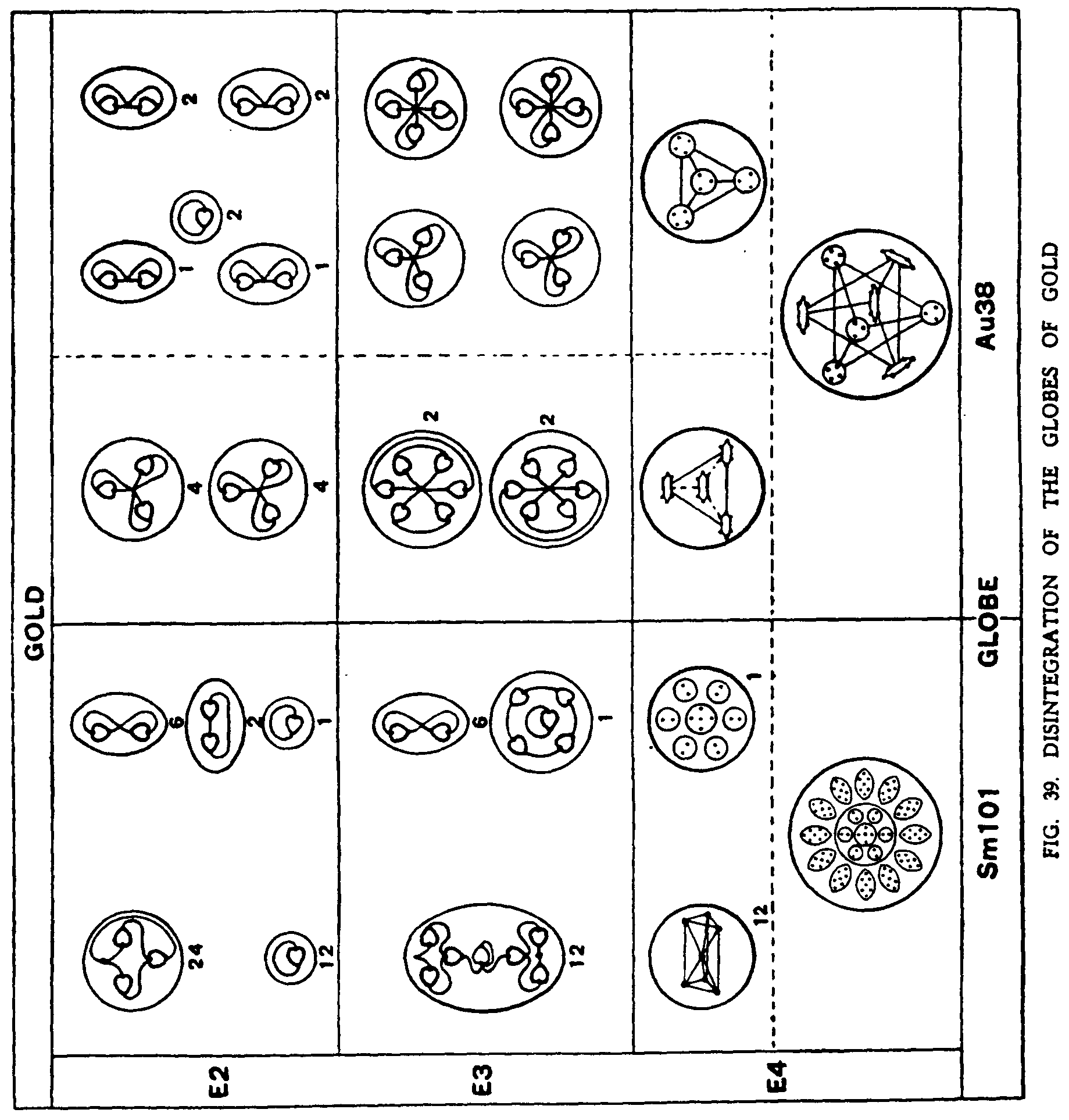
THE
DUMB-BELL GROUP 85
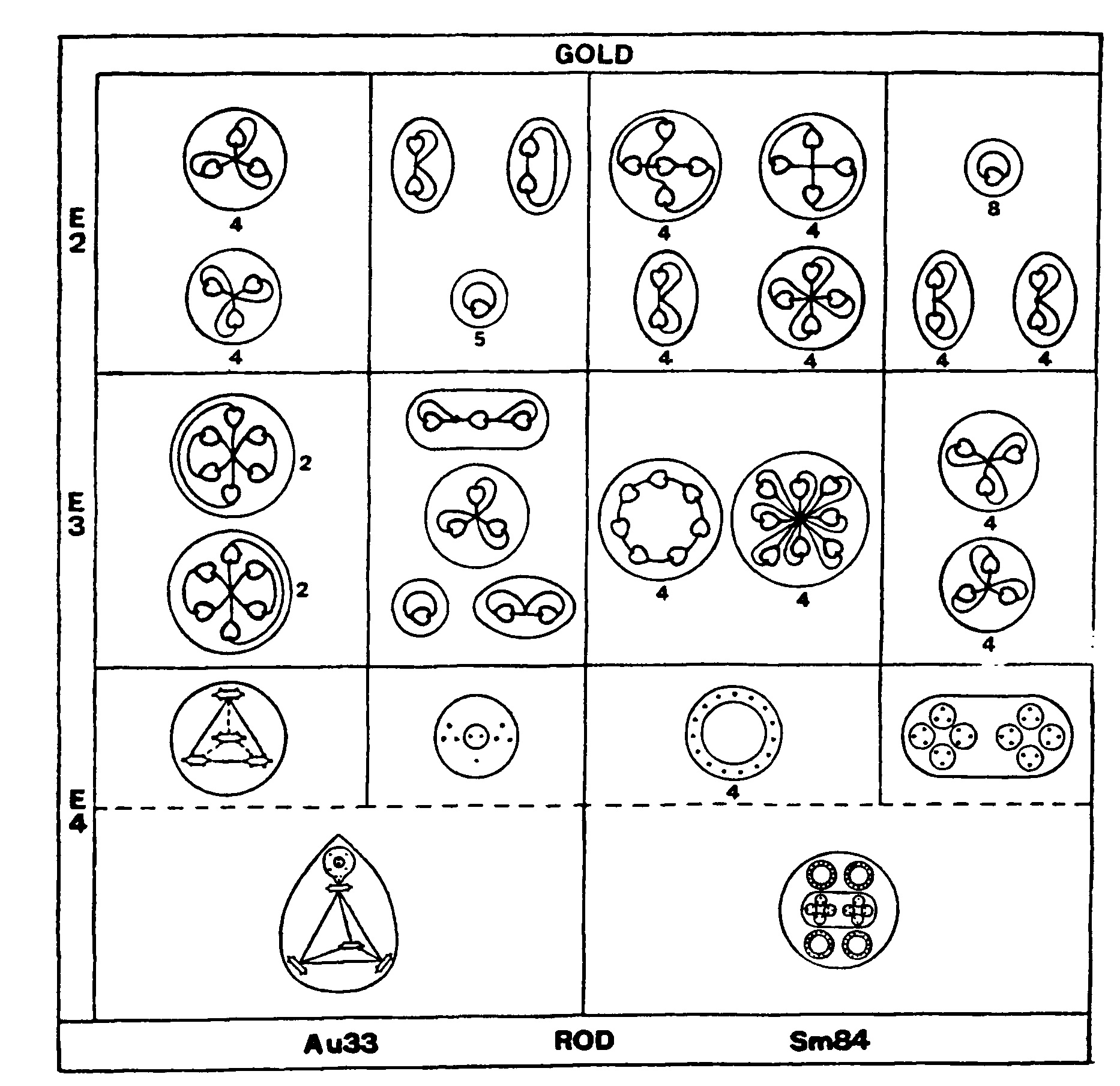
FIG.
90. DISINTEGRATION OF THE ROD OF GOLD
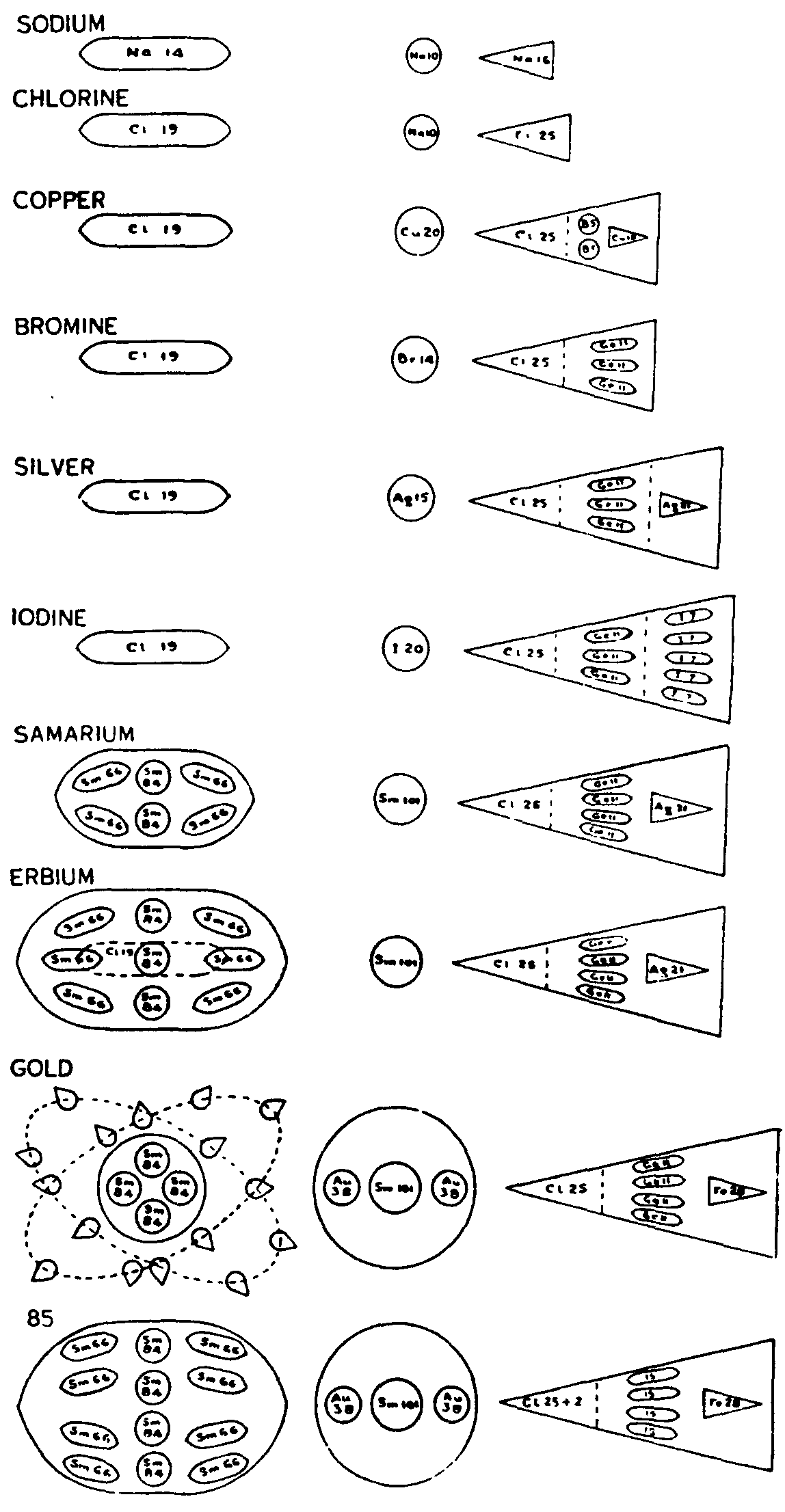
FIG. 91. THE DUMB-BELL CROUP